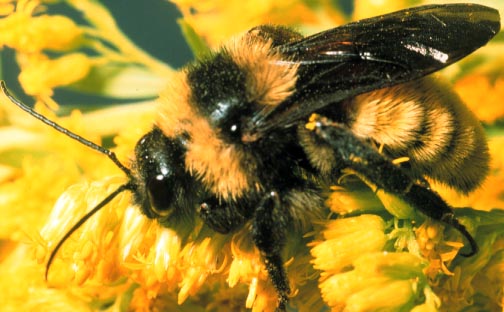
A bumble bee, Bombus sp. (Hymenoptera: Apidae), male. Photo by Drees.
Common Name: Bumble bee
Scientific Name: Bombus sp.
Order: Hymenoptera
Description: Bumble bees are easily recognized, being large (3/4 inch long) with black and yellow or orangish hair patterns on their abdomens. Queens and workers have pollen baskets on their hind legs. Bumble bees can be distinguished from carpenter bees because of the presence of orangeish or yellow hair patterns on the upper surface of the abdomen on the honey bee. Some members of bumble bees (Subfamily Bombinae) in the genus, Psithyrus, are parasites of bumble bees, feeding on larvae.
Life Cycle: Fertilized queens survive the winter, select an underground nesting site in the spring and construct a nest in which worker bees are raised. Queens lay eggs that hatch into larvae and develop through several stages (instars) before turning into a pupa. Male and female bees are produced later in the summer. In the fall, all members of the colony die except the fertilized queens.
Habitat, Food Source(s), Damage: Nesting sites include clumps of dry grass, old bird nests, abandoned rodent burrows, old mattresses, car cushions or even in or under old abandoned buildings. Most colonies contain a few hundred bees although thriving colonies can contain up to 2,000 bees. Nests may be up to 12 inches in diameter and may have several entrances. Foraging worker bees use long tongues to pollinate clovers and other flowers, collecting pollen and nectar that they bring back to the hive to feed to the colony . Honey is stored in the nest. Foraging activities occur only during the daylight hours.
Pest Status: Important pollinators; females are capable of stinging. They can be aggressive around nesting sites but they are rarely aggressive during foraging activities; occasionally a problem when their nest is located next to a building or walkway.
For additional information, contact your local Texas A&M AgriLife Extension Service agent or search for other state Extension offices.
Literature: Borror et al.1989; Hamman 1980.